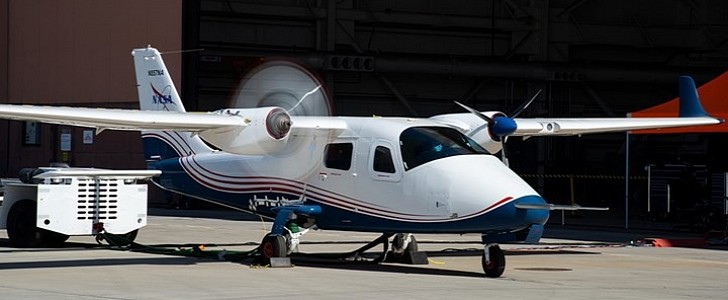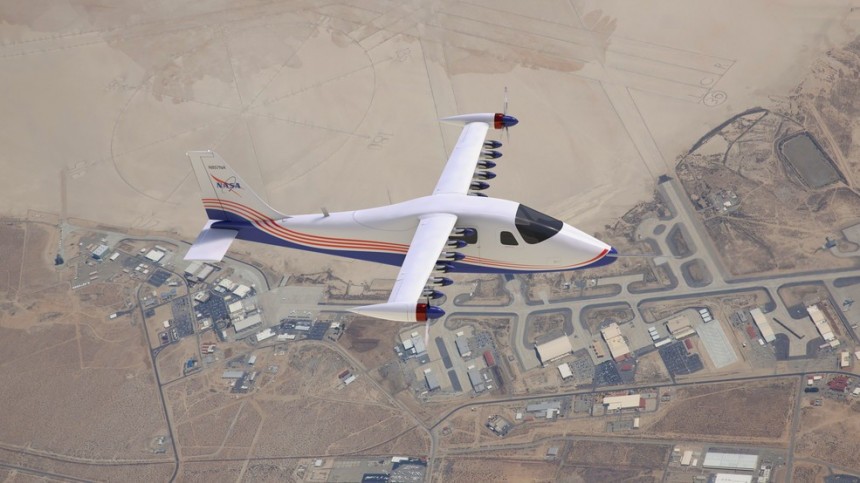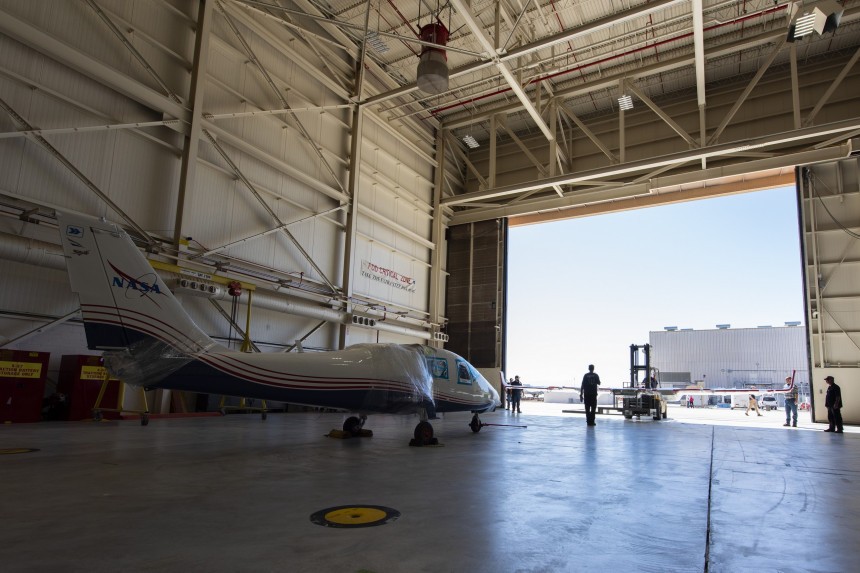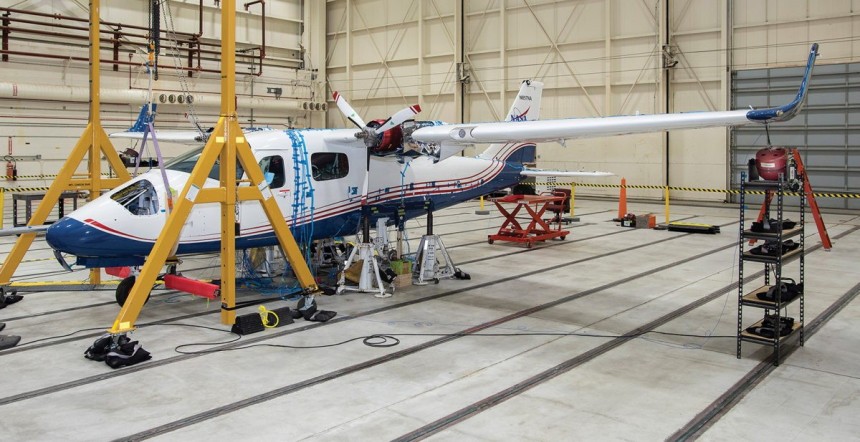For lack of better words, if you think all-electric cars are hard to build, heavier than air, manned electric airplanes make the cars look like toys. Until the late 20th century, the idea of an EV airplane was essentially preposterous, but not anymore.
Say hello to NASA's X-57 Maxwell, named after the Scottish physicist James Clerk Maxwell. It's a sustainably fueled, ultra-low-emission electric transport plane we bet nobody saw coming. The fact it exists at all may be somewhat of a newsflash for those who don't follow EVs closely. With its first test flight due to take place any day now, let's take a deep dive into the light EV cargo plane promising zero-emission aviation like never before.
For clarity's sake, the idea of an electrically powered aircraft is actually older than the advent of heavier-than-air powered flight itself. Check out our in-depth feature showing all the crazy requirements an EV aircraft has to meet before it can even lift off the ground if you want to learn more.
But what this meant for NASA was simple. Perhaps it's best to start with an existing airframe and retrofit it with electric motors instead of futzing around with an entirely new design. We're sure American taxpayers and NASA's accountants agree with that decision.
It's a design that's been due to be tested under the Leading Edge Asynchronous Propeller Technology (LEAPTech) initiative first unveiled by NASA in 2014. The derivative aircraft in question is not American in origin but rather Italian. A twin-engined Tencam 2006T.
A rugged, high-winged private passenger and cargo plane by trade, NASA engineers deemed the forgiving and stable nature of such a modest airframe perfect for developing EV battery technology that may or may not be ready for sustained flight at this juncture. As it hasn't flown yet, that's still up in the air.
As a prerequisite for service with NASA, the twin four-cylinder, air-cooled aircraft engines are gone. In their place is a series of 18 electric motors paired like fine wine and cheese to a bank of lithium-ion phosphate batteries that Elon Musk may or may not be jealous of. A number of different engines, propellers, and wing arrangements have been proposed for testing under the X-57 program.
Those of us who've been lucky to catch glimpses of the X-57s ground testing online caught glimpses of its standard-looking twin-propeller configuration. But plans are currently in the works to test designs utilizing different propeller setups, including an array of smaller props mounted across the front of the wing from end to end with wingtip mounted main propellers at each wingtip where the fuel tanks would normally sit.
With a wing-mounted propeller setup numbering as many as 12 at a time, it's hoped the added lift will help the aircraft maintain an excellent stall speed of around 58 km (107 km/h, 66.75 mph).
That's even less than some Second World War fighter planes. Color us impressed. Seeing as electric motors are smaller and lighter than jet engines of the equivalent power, at least usually, this shouldn't be a surprise at all.
The X-57 seats two, one pilot, and one co-pilot and is expected to have a range of around 100 miles (160.9 km) with max-powered flight times in the one-hour range. Granted, those performance numbers aren't all that impressive.
But as we said, getting an all-electric aircraft off the ground is one heck of an accomplishment all by itself. The optimized cruising wings provide just enough lift to maintain flight at slow speeds but are also light enough to give the electric motors a fighting chance of flying reliably at high and low speeds. At least, in theory, that is.
For a bit more context, the P2006T that the X-57 is based upon had a maximum cruising speed of 250 km/h (155 mph, 135 km) and a stall speed of 87 km/h (54 mph, 47 km). Granted, most of these stats eclipse the projected performance of the X-57.
But remember, these are only the projected performance figures at the current moment. Once the X-57 takes to the skies for the first time, expect NASA engineers to start pushing the envelope as much as they possibly can.
In the end, the X-57 is essentially a proof of concept vehicle intended to show that affordable, utilitarian electric air transportation is indeed possible and maybe even economically viable sometime in the not-so-distant future.
The X-57s first flight was scheduled to take place on February 24th, 2022, but has since been moved to later this spring. If successful, it will join the Rolls Royce Spirit of Innovation in a rapidly increasing group of the finest EV aircraft ever to fly. In the same way that the Spirit of Innovation's speed showed electric aircraft could be fast, it's hoped the X-57 Maxwell can prove that they're practical as well.
Check back soon for more from EV month here on autoevolution.
For clarity's sake, the idea of an electrically powered aircraft is actually older than the advent of heavier-than-air powered flight itself. Check out our in-depth feature showing all the crazy requirements an EV aircraft has to meet before it can even lift off the ground if you want to learn more.
But what this meant for NASA was simple. Perhaps it's best to start with an existing airframe and retrofit it with electric motors instead of futzing around with an entirely new design. We're sure American taxpayers and NASA's accountants agree with that decision.
It's a design that's been due to be tested under the Leading Edge Asynchronous Propeller Technology (LEAPTech) initiative first unveiled by NASA in 2014. The derivative aircraft in question is not American in origin but rather Italian. A twin-engined Tencam 2006T.
As a prerequisite for service with NASA, the twin four-cylinder, air-cooled aircraft engines are gone. In their place is a series of 18 electric motors paired like fine wine and cheese to a bank of lithium-ion phosphate batteries that Elon Musk may or may not be jealous of. A number of different engines, propellers, and wing arrangements have been proposed for testing under the X-57 program.
Those of us who've been lucky to catch glimpses of the X-57s ground testing online caught glimpses of its standard-looking twin-propeller configuration. But plans are currently in the works to test designs utilizing different propeller setups, including an array of smaller props mounted across the front of the wing from end to end with wingtip mounted main propellers at each wingtip where the fuel tanks would normally sit.
With a wing-mounted propeller setup numbering as many as 12 at a time, it's hoped the added lift will help the aircraft maintain an excellent stall speed of around 58 km (107 km/h, 66.75 mph).
The X-57 seats two, one pilot, and one co-pilot and is expected to have a range of around 100 miles (160.9 km) with max-powered flight times in the one-hour range. Granted, those performance numbers aren't all that impressive.
But as we said, getting an all-electric aircraft off the ground is one heck of an accomplishment all by itself. The optimized cruising wings provide just enough lift to maintain flight at slow speeds but are also light enough to give the electric motors a fighting chance of flying reliably at high and low speeds. At least, in theory, that is.
For a bit more context, the P2006T that the X-57 is based upon had a maximum cruising speed of 250 km/h (155 mph, 135 km) and a stall speed of 87 km/h (54 mph, 47 km). Granted, most of these stats eclipse the projected performance of the X-57.
In the end, the X-57 is essentially a proof of concept vehicle intended to show that affordable, utilitarian electric air transportation is indeed possible and maybe even economically viable sometime in the not-so-distant future.
The X-57s first flight was scheduled to take place on February 24th, 2022, but has since been moved to later this spring. If successful, it will join the Rolls Royce Spirit of Innovation in a rapidly increasing group of the finest EV aircraft ever to fly. In the same way that the Spirit of Innovation's speed showed electric aircraft could be fast, it's hoped the X-57 Maxwell can prove that they're practical as well.
Check back soon for more from EV month here on autoevolution.








